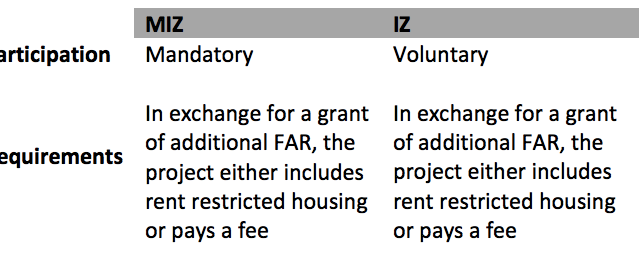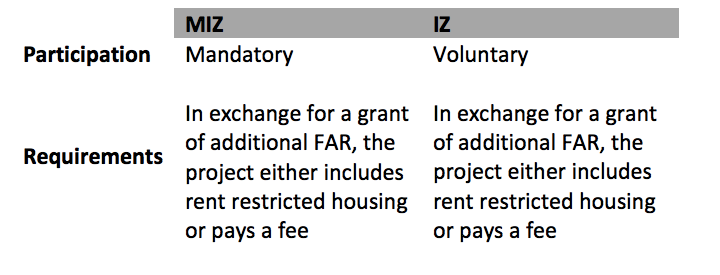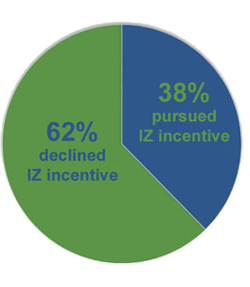It’s Not Too Late: A Look at the Flips and the Flops on Mandatory Inclusionary Zoning
Thou hast undone thyself, thy son and me;
And given unto the house of York such head
As thou shalt reign but by their sufferance.
To entail him and his heirs unto the crown,
What is it, but to make thy sepulchre
And creep into it far before thy time? . . .
And yet shalt thou be safe? such safety finds
The trembling lamb environed with wolves
. . . thou preferr’st thy life before thine honour
Queen Margaret to King Henry VI upon learning he had disinherited her son to end the War of the Roses
Henry VI, Part III, Act I, Scene 1, 250
I think the Mandatory Inclusionary Zoning (MIZ) is a mistake on a generational scale; we’ll look back years from now and ask, “What were they thinking when they put this in the code?” When I look back at how we got Mandatory Inclusionary Zoning (MIZ), a scheme that would grant additional square footage in exchange for rent restricted units or a cash fee, I can’t help but remember it all started with what was called “incentive zoning.” Incentive Zoning (IZ) was, in essence, the same as MIZ. The difference? Incentive zoning was voluntary. What’s peculiar is that many of the same people who opposed IZ when it was voluntary now support MIZ. What’s going on? Let’s compare the two programs side by side.
Here’s what Ada Healy, head of Vulcan’s real estate operation said about IZ a few years ago in a headline that could just as well apply to MIZ, “Incentive zoning: right sentiment, wrong tool:”
Developers are [avoiding a grant of additional FAR] choosing to build to the existing lower height, which means no funds for low-income housing and no additional supply of affordable units.
Why? According to a recent study by the Seattle City Council’s housing consultant, Cornerstone Partnership, 62 percent of developers are choosing not to participate in the program, suggesting that the fee structure in place does not create an incentive. As a result, the opportunity cost of thousands of housing units going unbuilt has generated less housing supply (which puts upward pressure on rents for everybody), fewer workforce and/or low-income units and loss of significant public benefits (jobs and tax revenue) due to projects built below zoned capacity.
Oddly, Vulcan now supports the program that forces participation, signing a letter that said
And at the center of this comprehensive set of strategies is the newly renamed Mandatory Housing Affordability-Commercial and Mandatory Housing Affordability-Residential programs, and the required upzones to implement both. The proposal is a smart balance of developer requirements and additional building capacity. These are critical and need to be adopted as proposed [emphasis mine].
As I pointed out a little while ago there are no numbers in the proposed framework. However, what is in the actual Grand Bargain document signed by Vulcan lobbyist Ryan “Swords Into Ploughshares” Bayne does appear to lock in the fees Vulcan would have paid in lieu of inclusion when they opposed the voluntary program. I guess Vulcan didn’t get exactly what they want, but they got what they need.
To be fair, Dan Bertolet was not at the Sightline Institute when he wrote:
It’s pretty simple: Most developers said “no thanks” to IZ because the incentive offered by additional development capacity was not sufficient to offset the additional risk and cost. And one component of that additional cost is the requirement to include subsidized affordable housing in the project, or to pay for its construction elsewhere, a.k.a. an in-lieu fee.
The post included the following graphic citing the same data Healy did and showing how incentive zoning really wasn’t much of an incentive:
Bertolet went on to say in a subsequent article, again before he joined Sightline, that
Ironically, the conceptual heart of the grand Grand Bargain itself is an impediment to the kind of cultural shift necessary to garner political support for upzones. The problem is that because the bargain sanctions a trade-off between upzones and affordability, it perpetuates the widely held misconception that allowing increased housing density is a necessary evil at best. But the truth couldn’t be any more opposite—the positive effect on affordability in particular, not to mention reduced sprawl and greenhouse gas emissions, along with improved human health and productivity.
Now that he’s at Sightline, Bertolet suggests that this “impediment” at the “conceptual heart” of MIZ is really a math problem:
But if the mandates are too large—if they are more onerous than the ever-shifting economics of housing construction will tolerate—the city stands to lose both new subsidized apartments and new market-rate apartments. And that outcome truly would be a disaster in a city where a shortage of housing is driving prices sky-high.
Hmmm. Seems like we already solved that math problem when the program was a voluntary one. The voluntary requirements were too large. Now that they are mandatory will the “ever-shifting economics of housing” be different? Maybe we’re heading for disaster. Who knows. We have no numbers. Like me, a liberal arts major, the City has assiduously avoided math.
Yet Sightline agreed, without the numbers necessary to do that math, that the MIZ plan is a “smart balance.” Bertolet also signed the Swords Into Ploughshares letter. (For fun, I’ve posted that whole letter down below. You better check to see if your name is on it. Interestingly only one attorney who signed the now well known letter pointing out that the City could not charge fees for development signed the ploughshares letters. I’ll let you figure out who that is and it isn’t Grand Bargaineer Jack McCullough.).
Let’s look at one more. Back in 2014 when efforts to oppose higher in leiu fees in the voluntary IZ program and linkage taxes were in full swing, A-P Hurd of Touchstone Development (a former supporter of Smart Growth Seattle) said about San Francisco’s program that taxes new housing,
“San Francisco’s program was a big success for the people who got an affordable-housing unit but it’s really terrible for everyone else,” said A-P Hurd, a vice president at Touchstone Corp., which has hotel, office and mixed-use projects under way in downtown and South Lake Union.
“If you care about affordability, your job is not just to build affordable housing; your job is to keep housing affordable for all the people who are in market-rate housing,” she said.
Later, after signing on to the Grand Bargain, Hurd said of MIZ that
It’s part of a much larger strategy to address housing affordability for all kinds of people in Seattle. “Some people will get a subsidized unit. But lots of people who move here will also be able to get a market rate unit,” she said. Without new capacity through zoning changes, she says many of those people would have a hard time finding a place to live [emphasis mine].
A fascinating restatement amounting to simply shifting from a glass half empty to a glass half full perspective, I guess. To be fair, the first Hurd quote was more about the linkage tax, but Hurd was always aligned with the idea that Incentive Zoning was not an incentive, and that adding fees and inclusion requirements would have the opposite result and would raise prices (she even once called the whole idea behind exactions on new development, “bullshit.”) And that was the basis of her first comment: it doesn’t make sense to tax new housing to pay for units for a lucky few that will get them. But that’s exactly what she now supports with MIZ.
The so-called Grand Bargain will negatively impact none of the people or organizations I mentioned here. After all, though their proxies they agreed to it because it was beneficial for them either politically or financially or both. However, the folks I talk to that build housing haven’t a clue how it might impact their latest deal of project because they’ve seen no numbers. The former allies I mentioned in this post don’t like me much any more. It’s impossible for them to intellectually reconcile their flip. It can’t be done. I guess that means no Christmas Card for me this year. The thing is, if they care what I think now, why didn’t they care what I thought then, had I been there.
Yes, I get the politics. But I get the calls from builders all over town trying to understand how this might impact their projects. These are people running small and medium sized family businesses that are concerned if this will ruin their livelihood or at least slow down their progress. They tell me they don’t want the additional FAR and what they want, is what Hurd promised in The Stranger, predictability, even while many of them can’t even build out the FAR they have!
A.P. Heard [sic], the head of the developer Touchstone, praised the bargain and said it represented greater predictability in the market for developers. She even claimed to be speaking “on behalf of the development community.”
She certainly wasn’t speaking for builders and developers outside Downtown and South Lake Union. In fact, with no numbers, developers outside Downtown and South Lake Union have no way to predict what the City’s mandate will actually do. All I can do is tell them to vest their projects as quickly as they can and maybe, hopefully, this will all go away after the larger developers downtown finalize their Grand Bargain and neighborhoods savage the proposal with the Council. Until then the same thing we said about IZ is true about MIZ, it just adds costs, uncertainty, risk, and will boost prices. Not a single thing has changed but the politics and the instinct toward self-preservation. And like land prices, the price of political expediency depends on your address.
————————————-
The Swords Into Ploughshares Letter. The phrase Swords Into Ploughshares is immortalized at the United Nations and is a references Isaiah, Chapter 2, Verse 3.
October 20, 2015
Committee Chair Mike O’Brien
Seattle City Council
Select Committee on Housing Affordability P.O. Box 34025
Seattle, WA 98124-4025
Re: Council Bill 118498 and Mandatory Housing Affordability program implementation
We are writing on behalf of a broad coalition of affordable housing developers and advocates, for-profit developers and businesses, labor and social justice advocates, environmentalists and urbanists, united together to build an equitable, prosperous, thriving, and inclusive Seattle by ensuring that the benefits of the city’s growth are shared by all current and future residents – from those struggling with homelessness to wage-earners and families. Under the banner Seattle for Everyone, we urge your strong support for the Housing Affordability and Livability Agenda (HALA) and the “Grand Bargain” provisions to produce and preserve critically needed affordable and market-rate housing in the City of Seattle.
We believe that the HALA recommendations represent the first ever comprehensive package of affordable housing policies that will provide for a growing, inclusive city over the coming decades. And at the center of this comprehensive set of strategies is the newly renamed Mandatory Housing Affordability-Commercial and Mandatory Housing Affordability-Residential programs, and the required upzones to implement both. The proposal is a smart balance of developer requirements and additional building capacity. These are critical and need to be adopted as proposed. The Grand Bargain will produce and preserve a record number of income-restricted units, accommodate population growth without sacrificing affordability, and leverage our significant public investments in light rail and bus transit by creating more opportunities for households of all incomes to live within easy access to jobs and schools. While MHA-Commercial and the associated upzones are the centerpiece of the Grand Bargain, the less headline-catching recommendations of tenant protections and review process reform are also essential.
Collectively, these recommendations represent a sea-change in affordable housing politics in Seattle. Now, a new alliance forged by common interests and shared objectives has put forth HALA and the Grand Bargain. We are excited to continue this game-changing alliance to build a diverse, equitable, and prosperous Seattle where the benefits of growth are shared by all. It is only fitting then that we have chosen to name our effort “Seattle for Everyone.”
The Seattle for Everyone coalition is built on the foundation of the HALA report and the Grand Bargain— and each of their components is critical to keeping this alliance together. Furthermore, the ambitious production targets for both market-rate and affordable housing can only be achieved through adoption of the whole package. Accordingly, we implore you to consider HALA and the Grand Bargain as a comprehensive proposal, rather than a menu from which to pick and choose. We urge you to adopt the numerous pieces of legislation required to implement HALA and the Grand Bargain and to minimize changes that would pit one faction against another, leading to more uncertainty, wasteful delay, less affordability and less housing supply. While we understand and respect the legislative process, the importance of following through on the HALA recommendations cannot be understated.

We look forward to working with you as you continue to implement HALA and the Grand Bargain. It is our hope that we can stand together several years from now and celebrate the HALA legacy of real affordability and livability for our city.
Sincerely,
Adam Dodge, Columbia City resident
Alan Durning, Executive Director, Sightline Institute
A-P Hurd, Touchstone Barrientos, LLC
Beacon Development Group
Bellwether Housing
Ben Broesamle, Magnolia resident Benjamin Gould, Fremont homeowner
Bridgette Maryman, NewHolly resident
Capitol Hill Housing
Charles R. Wolfe, Attorney at Law
Charlie Cuniff, Columbia City resident
Chris Rule, Greenwood resident Compass Housing Alliance
Dan Bertolet, Central District resident
Dave Freeburg, Belltown resident
David Moseley, Alliance for Pioneer Square
David Rolf, President, SEIU 775
DESC
El Centro de la Raza
Faith Pettis, Partner, Pacifica Law Group
Futurewise
Greg Smith, CEO, Urban Visions
Joe Geivett, Emerald Bay Equity
Jon Scholes, President and CEO, Downtown Seattle Association
Jonathan Hopkins, Denny Triangle resident
Josh Brower, Veris Law Group PLLC
Katherine F. Mackinnon, Ravenna resident
Keith Kyle, Olympic Manor resident
Kelly Rider, Director of Government Relations & Policy, Housing Development Consortium Seattle-King County
Lauren Craig
Mark Barbieri, Washington Holdings
Matt Gangemi, Queen Anne resident
Matthew Johnson Columbia City resident
Maud Daudon, President & CEO, Seattle Metropolitan Chamber of Commerce
Melissa Jonas, Beacon Hill resident
Mercy Housing Northwest
Mike Eliason, Fremont father
Mytoan Nguyen-Akbar, Lake City resident
Phillip Duggan, Pinehurst resident
Puget Sound Sage
Renee Staton, Pinehurst resident
Rob Harrison, Harrison Architects
Ryan Bayne, Coalition for Housing Solutions
SAGE Architectural Alliance
Sara Maxana, Ballard resident
Schemata Workshop
Scott Matthews, Sr. Director, Residential Development, Vulcan Real Estate
Seattle Subway, transit advocacy organization
Sharon Coleman, Board President, NAIOP
Sierra Club
SMR Architects
Tim Weyand, CEO, NK Architects
Tonkin Architecture
Transportation Choices Coalition
Uptown Alliance
Washington Low Income Housing Alliance
Zachary Pullin, Capitol Hill resident




